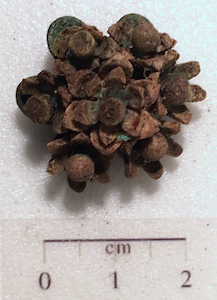By Dennis Piechota
Most objects encountered in the field are easily identified. But the identity of some, like this artifact from Coles Hill in Plymouth MA, can unfold slowly for the archaeologist and conservator.
When still partly covered with the soil of the excavation pit in the summer of 2016 this object looked like what is sometimes called an ‘eco-fact’, a natural product, in this case apparently a fragment of a pine cone. Then when freed from the soil its metal base and mounting pin were noted identifying this as a jewelry form, a brooch. During initial cleaning it looked like a delicate wood carving of a compound flower head composed of seven six-petal florets all mounted on a copper alloy base.
In the laboratory microscopic inspection showed the decoration was made not from one carving of a single block of wood, but from a complex of 15 separate miniature carvings that were assembled to form a flower.
Looking into the centers of each floret, away from the weathered edges, we see the carvings are actually translucent and white indicating they are not wood, even though their tips appear brown and opaque; the florets are all carved of ivory!
And the metal base of the flower held one more surprise. While we knew it was a copper alloy, probably brass, we could see a yellow finish here and there through the corrosion indicating the remnants of gold leaf.
While basic processing is now finished the research goes on with questions like what type of flower was this meant to be and what symbolism might it have held for the wearer?



